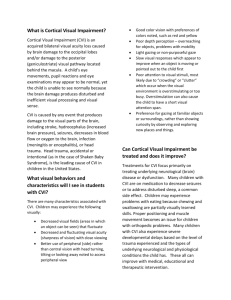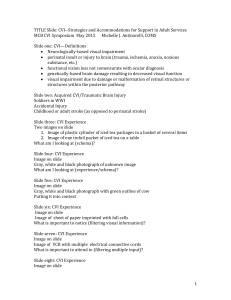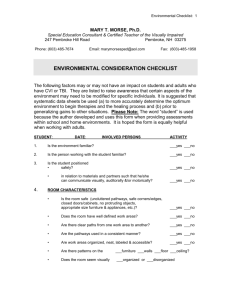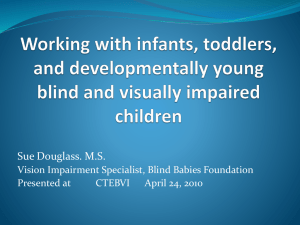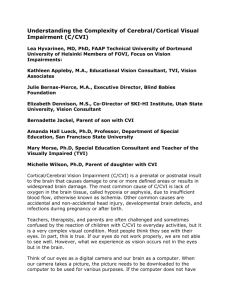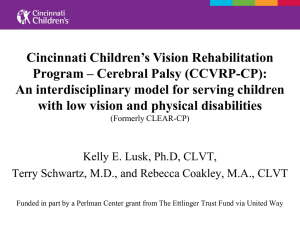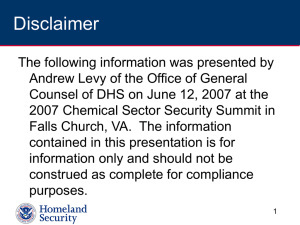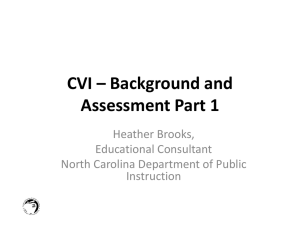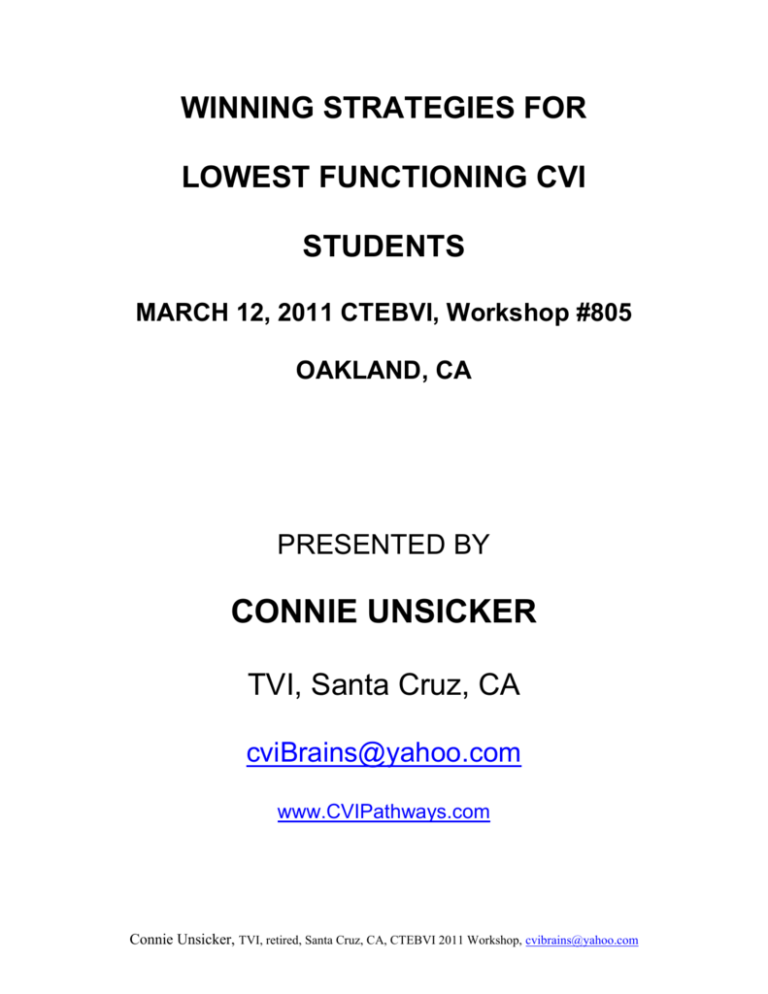
WINNING STRATEGIES FOR
LOWEST FUNCTIONING CVI
STUDENTS
MARCH 12, 2011 CTEBVI, Workshop #805
OAKLAND, CA
PRESENTED BY
CONNIE UNSICKER
TVI, Santa Cruz, CA
cviBrains@yahoo.com
www.CVIPathways.com
Connie Unsicker, TVI, retired, Santa Cruz, CA, CTEBVI 2011 Workshop, cvibrains@yahoo.com
WINNING STRATEGIES FOR LOWEST FUNCTIONING CVI STUDENTS
Presenter: Connie Unsicker
CTEBVI Saturday, 2:45 P.M., March 12, 2011
NEW Workshop #805 Description
The workshop description has been modified to include information for
parents. This workshop will review a “deck-ade” of research and practicum for
lower functioning CVI students. During the past 10 years, there’s been an
explosion of brain research helpful to teachers of the visually impaired working
with CVI children as well as those educating the general school population. We’ll
discuss how the brain works. There will be ideas for enhancing the healthy brain
and encouraging the development of the visual cortex and other compromised
areas of the brain. There will also be a summary of Lilli Nielsen’s and Christine
Roman’s research and publications which have improved our understanding and
ability to work more successfully with CVI students.
NEW Workshop #805 Goals
1. Participants will understand various Nielsen, Roman, and brain theories for
working with CVI students.
2. Participants will understand how to design their own appropriate lesson
plans for CVI students.
3. NEW- Parent participants will be encouraged to “repurpose” handy items
from their home to enhance the lives of their children.
Biography
The last 10 of 30+ years teaching, Connie Unsicker was TVI with majority
of caseload ages 3-22 CVI students. Attended 4 Lilli Nielsen Active Learning
conferences, 2 Christine Roman CVI trainings and AFB Brain Injury conference.
Attended 5 Learning and the Brain conferences where scientists presented brain
research results specific to education. Retired in 2008 but continually read books
summarizing brain research for laymen in effort to increase knowledge regarding
brain function of CVI students.
Connie Unsicker, TVI, retired, Santa Cruz, CA, CTEBVI 2011 Workshop, cvibrains@yahoo.com
Workshop Introduction
This workshop handout includes four kits to encourage using items CVIready inside our homes and out. The kits, Let’s Get Cleaned Up, Dust or Sweep
First?, Recycling Helps Our Earth, and Card Winning Strategies, all use available
materials in a multi-sensory way. The children’s book Our Apple Tree is modified
with multi-sensory items to enhance published children’s literature. Included is
Rural Walk which describes the multi-sensory items on a typical farm walk. A
itemized “Shopping List” concludes the handout for easy access to ideas.
The handout also includes descriptions of two published sources for
assessing CVI student assessment theory and data collection, as well as four
published sources for ideas and lesson planning.
1. Dr. Roman-Lansky’s CVI Range is the most comprehensive material for
assessing CVI students as well as writing of goals and objectives. 2. The APH
Sensory Learning Kit can be used for both assessment and lesson plans. 3. The
APH Light Box and 4. Dr. Lilli Nielsen’s Active Learning have many lesson
planning ideas.
Who Are These CVI Children?
Born fragile and premature with undeveloped organs, CVI children would
die immediately without medical technology. Tubes and lines are put into their
body openings and pierce their fragile skin all over. These life-giving lines bind
them when they want to move. They hang on and absolutely refuse to give up,
showing patience and tenacity. We can use that personality trait in helping them
learn.
Their families spend months trekking to the hospital, putting the rest of
their lives on hold. Instead of scooping up their newborn in their arms, parents
can only stroke a tiny leg here and there, let a miniature hand hold a finger.
Their lifelines are barriers to love.
What a happy day when they can bring their child home- finally! But, there
are many return trips to the hospital. Some are planned surgeries- closing heart
holes, removing eye cataracts, inserting trach tubes. However, the hell of
Connie Unsicker, TVI, retired, Santa Cruz, CA, CTEBVI 2011 Workshop, cvibrains@yahoo.com
emergency trips and emergency life-saving surgeries also begin during this first
year.
No one realizes when this premature baby survives, that a life of
ambulances and air lifts, emergency room visits, hours of waiting surgery
outcomes, and nurses living with the family round the clock becomes the norm
for this family. All through this their child is patient and tenacious.
Many times the CVI child isn’t the only child in the family. The balance of
trying for a normal life for the other siblings surrounded by all these medical
emergencies is very difficult. The continual strain of the emergencies and
setbacks, along with the constant presence of non-family members in the home,
can be too much for a marriage. There should be some special award for these
parents who manage to deepen their love with this challenge.
It’s easy to know the emotions and opinions of CVI children. They are
happy to see us. They break into full smiles of glee when they enjoy an item or
activity. They produce big frowns when they are angry or sad. Many times we
can change the frown with a change in an activity. We don’t have to guess about
subtle cues or mixed messages. They feel especially happy and proud when
they do something independently.
As CVI children grow, they will find new pathways around the damaged
areas of the brain, including the visual cortex. Because the brain is a very plastic
organ the healthy portions of the brain can enlarge and take over the function of
the non-working portions. It’s exciting to enter a classroom and see if the child’s
occipital lobe is working as well as last week and why not if it isn’t. Some days
all the brain parts work together and we can observe the quality of brain plasticity
at work. Other times only the brain stem is at work. It is a privilege to work with
these students who have endured so much, and are loved so much.
The Brain
Definitions
Amygdala- portion of the hippocampus of the limbic system which regulates fightor-flight
Connie Unsicker, TVI, retired, Santa Cruz, CA, CTEBVI 2011 Workshop, cvibrains@yahoo.com
Cerebrum- frontal cortex, the conscious mind
Limbic system- functions include emotion & memory. Amygdala is part of this
system.
Neurons- brain cells, gray matter
Pheromones- secreted chemicals we cannot detect, capable of impacting the
behavior of another individual of the same species.
Plasticity- reorganization of neurons so they have a new or different function in
the brain.
Synapses- the gap connecting neurons, where memory is created & stored.
Synesthesia- adding one sense to another in ways that reinforce them both or; a
combination of different ways of knowing about the same thing.
Vomeronasal organ- the accessory olfactory system at top of nose, detecting
pheromone information about gender, reproduction, & dominance & dangerous
odors.
General Brain Information
In the field of visually impaired children, those with cortically visually
impairment are an unusual group because their entire visual system is
compromised, as it weaves from the very front of the brain through to the
damaged visual cortex at the very back. The visual sense makes up 70% of the
entire brain, so we’ll discuss the brain’s visual system and how CVI children can
find new visual pathways.
The brain is a very plastic organ. It finds ways for stimuli to move through
and around damaged areas as well as allowing healthy portions to enlarge and
take over the function of the non-working parts.
Today’s workshop will explain how to help the visual system to learn, and
change, while encouraging the rest of the brain and body to develop to it’s fullest
potential. You’ll understand why much patience is required.
The brain is an incredible organ. You keep hearing what’s damaged and
not working so today we will discuss what is working, but first a general overview
of brain.
Connie Unsicker, TVI, retired, Santa Cruz, CA, CTEBVI 2011 Workshop, cvibrains@yahoo.com
The Brain
Our brains are very complex, but they are also just a simple, elegant set
of electrical and chemical transmissions. The brain’s three universal activities
are:
1)reacting to the surrounding environment. 2)integrating its parts, which is where
our CVI children have to “wake up” the visual cortex and 3) growing neurons.
Those three activities are what we call learning. Learning is the
inhabitation of emotions cascading throughout brain and the formation of memory
or habits.
Emotions
Emotions continually cascade the brain with sensations, creating chemical
changes that affect the entire brain. They are produced by parts of the brain
stem, including the limbic system (emotion & memory) and the amygdala
(regulates fight-or-flight). When we encourage emotional responses from our
students we are engaging their entire brain which is a way to arouse CVI
students.
One can change ones brain physiology by deliberately assuming the
appearance of an emotion and using “universal” facial expressions. Think of a
skunk’s odor. That facial expression of disgust is an example of a “universal”
expression.
Neurons and Synapses
Neurons are the brain cells that interweave emotions and memory to
create the mind. Synapses are the gaps connecting neurons, where the created
memory is stored.
Neural growth ebbs and flows throughout childhood. There are seven
measurable growth spurts in brain before age 3, then another six before age 26.
These growth spurts are overproduction or “exuberance” of the synapses!
At birth, synapses are at full adult levels. The number of synapses rises to twice
the adult level by age 1 or 2, then plateau for several years. They gradually
decline in number as they “specialize” by pruning back, and at that point the brain
is once again down to its adult level.
Connie Unsicker, TVI, retired, Santa Cruz, CA, CTEBVI 2011 Workshop, cvibrains@yahoo.com
Teens
During teen years a second set of measurable neural growth spurts occur,
duplicating the birth to age 5 rate again, creating twice the number of synapses
as adults have once again. However, this brain growth occurs in quantum leaps,
not gradually.
Growth occurs first in the teen’s emotion-centered limbic system and last
in the cerebrum, the frontal cortex, home of the conscious mind. During this
time, teens use the amygdala, not frontal cortex as adults do. Reaction to
emotions is at the instinctual level.
The teen body readies for reproduction with an increase in the powerful
brain chemicals, testosterone and estrogen, affecting many brain functions.
Boys may become more aggressive as testosterone receptors increase in the
amygdala. Girls, with increased estrogen, prepare for mothering by withdrawing
from parents, and wanting to be alone or together with peers.
CVI Brain
Our olfactory sense (Vomeronasal organs) is one of the two senses, along
with vision, which permeates the brain. It is made up of two parallel parts which
bypass the cerebral cortex. They link directly to two important portions of the
brain, one where long-term memory is formed, and the other, a section which
processes several emotions including fear, anger, and pleasure.
How can we encourage learning, using these healthy, working portions of
the brain? We should include all the senses and in combination. Synesthesia is
the addition of one sense to another in ways that reinforce them both or is a
combination of different ways of knowing about the same thing. This works well
when the child is healthy but can also be used on those days when s/he isn’t
feeling well to distract from symptoms, get a smile, and allow emotions to
cascade throughout brain.
We all yearn to be a social being. Using emotions, we give our students a
chance to communicate with the world around them. It’s a wonderful way for our
students to be less isolated, engage with others, be part of their community
socially, and let others know they want to communicate.
Connie Unsicker, TVI, retired, Santa Cruz, CA, CTEBVI 2011 Workshop, cvibrains@yahoo.com
Facial & head stimulation is an excellent way to arouse CVI children.
They love to have their heads covered & uncovered. The majority of the body’s
tactile nerves are located on the head and face. The majority of those facial
tactile nerves are in the mouth area. Mouthing is the good way for many CVI
children to gather complex information. They use the supersensitive mouth-nose
triangle to learn textures, smells, shapes of objects.
It requires enormous energy to “jump-start” the visual cortex. We
measure changes in tiny seconds. Abundant patience is required of us while the
visual system develops. But, remember, when working with CVI children, “use it
or lose” is the rule. We’re all facilitators in this process.
ROMAN CVI RANGES
The Roman CVI Range contains the best forms for assessing an
individual’s specific CVI vision and, later, measuring gains in ability. In Cortical
Visual Impairment: An Approach to Assessment and Intervention, Dr. Christine
Roman-Lansky, begins with children who only stare at lights and describes ten
levels of functional vision, in three different general phases, using ten different
characteristics or visual qualities.
The following list is adapted from the forms "The CVI Range:
Across-CVI Characteristics Assessment Method" found on pages 188-192 of
Cortical Visual Impairment: An Approach to Assessment and Intervention.
Please notice the resolution of various characteristics as the Range moves from
1-2 to Range 9-10. For example, follow the descriptions of color use in each
range.
The CVI Range: Across-CVI Characteristics Assessment Method
CVI Range 1-2:
Student functions with minimal visual response
May localize, but no appropriate fixation on objects or faces
Consistently attentive to lights or perhaps ceiling fans
Connie Unsicker, TVI, retired, Santa Cruz, CA, CTEBVI 2011 Workshop, cvibrains@yahoo.com
CVI Range 1-2: cont’d
Prolonged periods of latency in visual tasks
Responds only in strictly controlled environments
Objects viewed are a single color
Objects viewed have movement and/or shiny or reflective properties
Visually attends in near space only
No blink in response to touch or visual threat
No regard of the human face
By permission of the publisher, from Cortical Visual Impairment: An Approach to Assessment and
Intervention, by Christine Roman-Lantzy, copyright (c) 2007, AFB Press, American Foundation for the
Blind. All rights reserved.
Dr. Roman’s Range 1-2 definitions and the BBF CVI Fact Sheet correlate.
The APH Light Box Level I and Active Learning activities are excellent for the
Range 1-2 child. Visual portion of brain very disorganized, very difficult to excite
visual pathways.
The CVI Range: Across-CVI Characteristics Assessment Method
CVI Range 3-4:
Student functions with more consistent visual response
Visually fixates when the environment is controlled
Less attracted to lights; can be redirected
Latency slightly decreases after periods of consistent viewing
May look at novel objects if they share characteristics of familiar objects
Blinks in response to touch and/or visual threat, but the responses may be latent
and/or inconsistent
Has a “favorite” color
Shows strong visual field preferences
May notice moving objects at 2 to 3 feet
Look and touch completed as separate events
By permission of the publisher, from Cortical Visual Impairment: An Approach to Assessment and
Intervention, by Christine Roman-Lantzy, copyright (c) 2007, AFB Press, American Foundation for the
Blind. All rights reserved.
Connie Unsicker, TVI, retired, Santa Cruz, CA, CTEBVI 2011 Workshop, cvibrains@yahoo.com
A student in Range 3-4 still has the characteristics described by BBF.
The APH Light Box Level I and Active Learning are still appropriate. Not so
interested in other colors yet, but has chosen either red or yellow as the preferred
color.
The CVI Range: Across-CVI Characteristics Assessment Method
CVI Range 5-6:
Student uses vision for functional tasks
Objects viewed may have two to three colors
Light is no longer a distracter
Latency present only when the student is tired, stressed, or overstimulated
Movement continues to be an important factor for visual attention
Student tolerates low levels of background noise
Blink response to touch is consistently present
Blink response to visual threat is intermittently present
Visual attention now extents beyond near space, up to 4 to 6 feet
May regard familiar faces when voice does not compete
By permission of the publisher, from Cortical Visual Impairment: An Approach to Assessment and
Intervention, by Christine Roman-Lantzy, copyright (c) 2007, AFB Press, American Foundation for the
Blind. All rights reserved.
In Range 5-6, some BBF characteristics still apply, i.e. movement. APH
Light Box Level II can be introduced at Range 5-6. My students now use Active
Learning equipment in a different way.
At Range 5-6, it becomes easier for students to participate in regular
classroom lessons if visuals are adapted for acuity & lessons paced for latency.
Corrective lenses become more important to improve vision and provide a frame
to help focus attention. Visual pathways are becoming stronger.
Connie Unsicker, TVI, retired, Santa Cruz, CA, CTEBVI 2011 Workshop, cvibrains@yahoo.com
The CVI Range: Across-CVI Characteristics Assessment Method
CVI Range 7-8:
Student demonstrates visual curiosity
Selection of toys or objects is less restricted, requires one to two sessions of
"warm up"
Competing auditory stimuli tolerated during periods of viewing; student may now
maintain visual attention on objects that produce music
Blink response to visual threat consistently present
Latency rarely present
Visual attention extends to 10 feet with targets that produce movement
Movement not required for attention at near distance
Smiles at/regards familiar and new faces
May enjoy regarding self in mirror
Most high-contrast colors and/or familiar patterns regarded
Simple books, picture cards, or symbols regarded
By permission of the publisher, from Cortical Visual Impairment: An Approach to
Assessment and Intervention, by Christine Roman-Lantzy, copyright (c) 2007, AFB
Press, American Foundation for the Blind. All rights reserved.
In Roman Range 7-8 the BBF list no longer applies! In my experience
latency is reduced but still exists in CP students. Visual pathways almost
established.
The CVI Range: Across-CVI Characteristics Assessment Method
CVI Range 9-10:
Student spontaneously uses vision for most functional activities
Selection of toys or objects not restricted
Only the most complex environments affect visual response
Latency resolved
No color or pattern preferences
Visual attention extends beyond 20 feet
Views books or other two-dimensional materials, simple images
Connie Unsicker, TVI, retired, Santa Cruz, CA, CTEBVI 2011 Workshop, cvibrains@yahoo.com
CVI Range 9-10: cont’d
Uses vision to imitate actions
Demonstrates memory of visual events
Displays typical visual-social responses
Visual fields unrestricted
Look and reach completed as a single action
Attends to two-dimensional images against complex backgrounds
By permission of the publisher, from Cortical Visual Impairment: An Approach to Assessment and
Intervention, by Christine Roman-Lantzy, copyright (c) 2007, AFB Press, American Foundation for the
Blind. All rights reserved.
In Range 9-10, visual functions are resolved!
Dr. Roman has extended
Range 9-10 so there are many more detailed steps than in Ranges 1-8. She
devotes an entire chapter to Range 9-10, taking into account the findings of Dr.
Dutton. Visual pathways established so visual dysfunctions may be permanent.
APH SENSORY LEARNING KIT (SLK) by MILLIE SMITH
The Sensory Learning Kit (SLK) is to use with profoundly delayed CVI students,
providing equipment and instruction for completing sequenced routines. It
contains various electronic and other objects along with a thorough two volume
manual of instruction, forms, practicum, and the theory behind them.
SLK Routines Book, Using the Sensory Learning Kit has information on
introduction of switches, sensory systems, alert levels, goals, lesson plans, a list
of simplest responses, as well as Routine cautions and samples of sequences. It
then continues with 100 pages of Routines information. It includes a form titled
“Routine Worksheet/Lesson Plan form” helpful for planning.
Guide Book and Assessment Forms for Using the Sensory Learning Kit, is a
nearly 200 page guidebook and forms. It has 5 multi-paged reproducible
assessment forms as well as CD templates and completed samples. The forms
are:
Connie Unsicker, TVI, retired, Santa Cruz, CA, CTEBVI 2011 Workshop, cvibrains@yahoo.com
1. Sensory Learning Summary- current status summary form of successful 6
sensory channels data collection.
2. Arousal State Profile- Helps with Assessment portion of IEP & is designed to
be updated.
3. Sensory Response Record - helps with Learning Media Assessment, Present
Levels, goal writing and progress report writing of IEP.
4. Appetite/Aversion List helps writing objectives and lesson plans.
5. Level and Strategy Guide also helps writing objectives and lesson plans and
can also be used as an alternative assessment.
DR. LILLI NIELSEN’S ACTIVE LEARNING
Dr. Lilli Nielsen is a Danish psychologist who worked for over 40 years
with visually impaired people who have additional disabilities- even Pre-Light Box
students who have no visual response.
Active Learning Theories of Dr. Lilli Nielsen
“Active Learning is based on creating optimal supportive environments
where learners can take action independently & LEARN ON THEIR OWN. The
environment supplies strong responses in multiple modes (auditory, tactile,
visual, & olfactory). The environment must be thick with objects so that minor
actions are rewarded with feedback.
“The challenged learner is alert & actively engaged. The learner may not
appear to accomplish anything, but the time is productive.” (TSVIB website)
The students learn more while no one is talking. Only after the student is
finished does Dr. Nielsen suggest the observer always summarize the completed
activity with the student. This gives language and meaning to the feelings the
child had while exploring. Always describe the student’s favorite part where the
biggest smile and the loudest utterances were observed.
Connie Unsicker, TVI, retired, Santa Cruz, CA, CTEBVI 2011 Workshop, cvibrains@yahoo.com
Dr. Lilli Nielsen Active Learning Equipment
see- http://www.lilliworks.com
1. Resonance Board
2. HOPSA dress
3. Support Bench
4. Little Room
6. SPG (Scratch, Position, & Grab) Board
7. Vest
8. Tipping Board
9. Position Board
Lilli Nielsen Active Learning Items designed by Unsicker
1. ACTIVE LEARNING BINDER- Three inch 3 ring binder to be used on desk in
easel position or open, standing on base. Multi sensory items are attached to
elastic & wire ties put through holes and on the 3 rings.
2. ACTIVE LEARNING VEST- Hand towel pinned around neck with multi
sensory items attached with diaper pins ONLY (for safety) directly to towel or on
elastic.
3. ACTIVE LEARNING POMPOM- Multi sensory items tied to strands of the mop
head and plop on hands for students with most restricted movement, unable to
move to mouth.
IDEAS FOR HOME
Connie Unsicker, copyright 2005
Encourage use of vision at the appropriate level of your child. In
addition, use his/her senses of smell, hearing, and touch as much as possible.
CVI children enjoy repetition, more than novelty. Take advantage of our powerful
sense of smell when brushing teeth, eating, etc.
When on walks, notice all good and bad smells as you stroll. (VI people
use smell as part of orientation, etc.)
Bad smells interest lots of my students-
Connie Unsicker, TVI, retired, Santa Cruz, CA, CTEBVI 2011 Workshop, cvibrains@yahoo.com
avoid only if they immediately grimace. Notice the type of air on the face- warm,
cold, soft, windy, etc. Allow the various path textures to vibrate up through the
wheelchair, edging plants brush his/her face.
Let him/her be in the kitchen while cooking. Let him/her touch and hear
the sounds of food and preparation. Let him/her smell raw onion before it
caramelizes when cooked, feel and smell raw potato vs. cooked, herbs, smoothie
items before & after, etc. Help him/her turn on the blender and watch toast pop
up.
Name an object, and describe what he’ll see, then show it to him/her.
(Think about being told the Canadian flag is a picture of 2 men arguing rather
than a leaf.) Be quiet while s/he experiences it, knowing its name.
Remember, your child is happy when you’re happy. Your child can’t
play unless you are having fun also. So, sit back, be silent and wait very
patiently while s/he explores and reacts to the environment and activities.
2011 KITS
A = Auditory O = Olfactory V = Visual T = Tactile E = Teacher use
Our Apple Tree,
by Gorel Naslund,
children’s book adapted for multisensory lesson
Dried apples = T, V, O
Flower bud = T, V
Bee toys = A, T, V
Perfumed flower = A, T, V, O
gold, red, pink apples = A, T, V, O
seeds = A, T
spiced applesauce = T, O
gummy worm = T, V, O
leaves = A, T, V, O
Connie Unsicker, TVI, retired, Santa Cruz, CA, CTEBVI 2011 Workshop, cvibrains@yahoo.com
Let’s Get Cleaned Up
Written for 2007 CTEBVI
Turn light bathroom switch on and off. “It’s light, it’s dark”- A, T, V
“Let’s wash our hands”= soap bar, little & big- O, T, V
“Now we bathe”= Body wash - O, V
“Scrub off the dirt”= body scrubber- T, V
“Wash our face”= little wash cloth- T, V
“Shampoo our hair”= shampoo- O, V
“Dry off”= Big towel- T, V
“Clean our ears”= Q-tips- T, V
“Brush our hair”= hair brush- T, V
“Now comb it”= comb, little & big - A, T, V
“Apply hair mousse”- A, O, T,
“Brush our teeth”. Squeeze on some smelly toothpaste, little & big - O, T, V
on a soft toothbrush- T, V
“Fix that hurting cut”= rubbing alcohol- O
“And put on a bandage”= Band-aid- O, T, V
If we’re a teen= Clearisil- O
If we’re old= Aspercream- O, V
If we’re a baby= Baby oil- O, T
Recycling Helps Our Earth
“Let’s throw or push cans into recycling bin.” = A, V
“Let’s throw or push plastic bottles into the recycling bin.” = A, T, V
“Let’s throw or push metal nails, screws into recycling bin.” = A, T, V, O
“Let’s rip colorful paper or magazine pages, then recycle.” = A, T, V
“Let’s tear off aluminum foil, crush, then recycle.” = A, T, V
“Let’s recycle cardboard.” = T, V, O
“Let’s not use bad packaging.” = A, T, V
“Let’s not use plastic bags (wave), then put away.” = A, T, V
“We should use cloth shopping bags.” = T, V
Connie Unsicker, TVI, retired, Santa Cruz, CA, CTEBVI 2011 Workshop, cvibrains@yahoo.com
Do We Dust Or Sweep First?
Written for 2007 CTEBVI
Feel all the textures, move the tools, smell the scents.
“Let’s dust”- Cough, cough and wave hands, “lots of dust”.
Spray Lemon Pledge into towel, then smell= A, O
Soft feather dusters= T, V,
Round yellow duster= T, V
Rough orange duster mitt= T, V
Soft, bright green duster mitt= T, V
“Now we sweep”- swish, swish
Match rough brushes with dust pans= A, T, V
Sweep up beans?= A, T, V
Sweep with soft yellow brush= A, T, V
“Let’s wash dishes”- splish, splash
Tub with warm water and suds= A, O, T, V
Smell dish detergent= O,T, V
Wash glasses with brushes- soft, firm, rough, sticks to counter= A, T, V,
Wash with sponges, squeeze- smooth, match colors= T, V
Scrub with scrubbers- shiny, rough= T, V
“Wipe counters with cloths”- Choose, name colors= T, V
“Scrub toilet bowl”- Match colors & put brushes in & out holder= A, T, V
Suggested Scent Kit
Use cloth teabags for small, squeezable herbs and a tray for the larger
noisy items to roll on, bang, swish, etc. Make sure all herbs are eatable.
Whole allspice= A, O, T, V
Bay leaves= A, O, T, V
Rose hips= A, O, T, V
Cinnamon sticks= A, O, T, V
Star anise= O, T, V
mint leaves in bags= A, O, T
lavender in bags= A, O, T
Connie Unsicker, TVI, retired, Santa Cruz, CA, CTEBVI 2011 Workshop, cvibrains@yahoo.com
Card-Winning Strategies
“Let’s play a card game.”
“We’ll need dice”= A, T, V
“Should we use poker chips?” in noisy can= A, T, V
“Or should we use money?” (coins) in noisy can= A, T, V
“We need a deck of cards”, red and blue= A, T, V
“Time to shuffle and deal.” Automatic card shuffler= A, T, V
“We always have cigars”= A, O, T, V
“Time for snacks!” soda cans= A, T, V
plastic bottled colored soda= A, T, V
pretzels, chips, nuts= A, O, T, V
“Oh, no, not strip poker! You lost, give me your socks!” = T, V
“Boy, oh, boy, did I lose big! Here’re pink slips for my cars and boats”= A, V
Multi-Sensory Rural Walk
Connie Unsicker, copyright 2006
“When the walk is over, I’m going to ask you what your favorite part of
the walk was.” During walk, acknowledge his feelings by verbalizing them as you
see them.
If your child is unable to reach out to touch, you can use a ruler as an
extender by wrapping a towel around as a handle. Let the ruler bang against the
fence, wall, etc., listening to the sounds as the touch vibrates down his/her arm.
1.
“It is hot/ chilly, feel the sun, breeze on your face.”
2.
“The driveway feels bumpy. Listen, we roll over crunchy oak leaves.”
3.
“Smell the dried oak leaf. Smell fresh oak leaf.”
4.
“We’re going downhill.”
5.
“We’re on quiet grass.”
6.
“Here’s the car. The handle’s hot/ brrr cold.”
7.
“Slam the door- it’s loud.”
8.
“We’re turning left to go see the chickens.” Press and push the left
shoulder.
Connie Unsicker, TVI, retired, Santa Cruz, CA, CTEBVI 2011 Workshop, cvibrains@yahoo.com
9.
“We’re on green/ dry grass. It’s quiet & hard to push. We go slow.”
10.
“Oops, we’re going downhill, it’s steep. It’s rocky.”
11.
“Listen to the chickens, their soft noises/cluck loudly/ scratch dirt.”
12.
“Feel the warm egg.”
13.
“We’re backing up. It’s so rocky & bumpy! We’re going slow.”
14.
“We turn right. We’re on a soft dirt road.” Press and push the right
shoulder.
15. “We’re in the shade. Listen to the sounds- birds/ leaves in breeze.”
16. “Smell the fresh bay leaf. (Smell a dried bay leaf- it’s so different!)”
17. “We’re in & out of the sun in dappled shade.”
18. “Here’s the big yellow fire hydrant. It’s tall & cold. Is it smooth?”
19. “Here’s a metal sculpture. Look at the bright shiny top. If we tap it with
a stick-it makes music. Tap it soft/hard fast/slow /with rhythm. It’s loud &
deep. The silver makes a higher tone.”
20. “Let’s turn around & go home.” You can review/point out items he
enjoyed when outbound.
When you return to house, choose 2 things to ask which was his/her
favorite part today, i.e. “Did you like the chickens or Elmo best today? Did
you like the chickens best, yes or no. Did you like Elmo best, yes or no.”
You can even say you noticed him grinning at the ______ today.
Connie Unsicker, TVI, retired, Santa Cruz, CA, CTEBVI 2011 Workshop, cvibrains@yahoo.com
BIBLIOGRAPHY
Dr. Lilli Nielsen
Books, videos, and equipment are available from Lilliworks at www.lilliworks.com.
The FIELA Curriculum: 730 activities, schedule board, Inst Manual (Summary of
FIELA curriculum -tsbvi.edu/Outreach/seehear/fall05/fiela.htm)
Functional Scheme: Functions Skills Assessment
Early Learning Step by Step
Spatial Relations In Congenitally Blind Infants
Educational Approaches
Are You Blind?
Space and Self
The Comprehending Hand
Dr. Lilli Nielsen VideosPerceptualizing Aids: Why, How and When? - Dr. Nielsen explains the HOPSA
Dress, Support Bench, & Essef Board.
Perceptualizing Aids Two: Why, How and When? Dr. Nielsen explains the Little
Room, & the MFA (Multi- Functional Activity) Table
Articles About Lilli Nielsen’s Active Learning
General information & links -tsbvi.edu/edu/recc/mivi.htm
Good overview- http://www.tsbvi.edu/Outreach/seehear/fall03/lilli.htm
Description of equipmenthttp://www.tsbvi.edu/Outreach/seehear/winter04/active.htm
Description of how child engages in Little Roomhttp://www.lilliworks.com/new_page_1.htm
Connie Unsicker, TVI, retired, Santa Cruz, CA, CTEBVI 2011 Workshop, cvibrains@yahoo.com
Dr. Christine Roman-Lansky Cortical Visual Impairment An Approach to Assessment and Intervention,
Roman-Lantzy, Christine, AFB Press, New York, NY, 2007.
Proceedings Summit on Cerebral/Cortical Visual Impairment Educational, Family,
& Medical Perspectives April 30, 2005.- Elizabeth Dennison & Amanda
Hall Lueck, Editors, published by AFB, 2006. (Roman, Dutton, many
others!)
CVI information, links, & Synergy committee- sun1.aph.org
Video- CVI Perspectives (1-30014-00/1-30014-00DVD) APH
Other Helpful Sources
Bright From the Start, The Simple, Science-Backed Way to Nurture Your Child’s
Developing Mind from Birth to Age 3, Stamm, Jill, Gotham Books, New
York, 2007. In parent-friendly language, describes newest brain research
and how this benefits understanding our children’s development during the
first 3 years of life.
“Child-Guided Strategies for Assessing Children Who Are Deafblind or have
Multiple Disabilities: The Van Dijk Approach to Assessment”
paper & CD, Nelson, Catherine & Van Dijk, Jan, available from APH.
Crashing Through, A True Story of Risk, Adventure, and the Man Who Dared to
See, Kurson, Robert, Random House, New York, 2007. Wonderful
descriptions of how CVI folks might see & how difficult processing is when
what you’re seeing isn’t named beforehand.
Getting Dressed for the Day, incomplete info., Light Bright Books, Durango, CO.
Transparent picture book for APH Light Box use.
The Mind’s Eye, Sacks, Oliver, Knopf, New York, New York, 2010
Excellent book describing various types of seeing when vision
neurologically impaired.
My Stroke of Insight, Taylor, Jill Bolte, Plume Books, New York, New York,
2006. Descriptions of brain injury as it occurs while neuroscientist
experiences a stroke. Continues with rehabilitation and adaptations to
permanent changes. May help us better understand CVI students and
their learning processes.
Our Apple Tree, Naslund, Gorel Kristina, Roaring Brook Press, New Milford, CT,
2002. Children’s book that can be adapted for CVI.
Connie Unsicker, TVI, retired, Santa Cruz, CA, CTEBVI 2011 Workshop, cvibrains@yahoo.com
SLK Routines Book, Using the Sensory Learning Kit, and SLK Guidebook and
Assessment Forms, Using the Sensory Learning Kit, Smith, Mille,
American Printing House for the Blind, Louisville, Kentucky, 2005.
Traveling Blind, Life Lessons from Unlikely Teachers, Fogg, Laura, Medusa’s
Muse Publishing, Ukiah, CA, 2007 Excellent descriptions of subtle, slow
changes CVI students make, techniques for working with them, & captures
the daily details unique to the job of a VI itinerant.
When You Have a Visually Impaired Student With Multiple Disabilities in Your
Classroom, A Guide for Teachers, Erin, Jane, Spungin, Susan, AFB
Press, NY, 2004.
Helpful Websites
BBF CVI Fact Sheet- http://66.147.244.207/~blindbab/wpcontent/uploads/2010/08/Fact-Sheet-CVI-REVISED-FINAL.pdf
Mary Morse presentation- good descriptions of practical ways to work with CVI
students. 2008 JTLI conference at:
http://www.afb.org/Section.asp?SectionID=28&TopicID=92&DocumentID=
4134 Click on “An Overview of Some Educational Techniques to Use
During High Teaching Times” and ”Environmental Consideration
Checklist”
RAFT Project directions pages (Resource Area for Teachers), an organization
which supplies teachers with recycled materials, workshops, & curriculum
ideas-http://www.raft.net/index.php?pg=teachers Then click on “Idea
Sheets”.
Texas TSBVI site full or ideas for parents and teachershttp://www.tsbvi.edu/Outreach/seehear/archive/
SHOPPING LIST (IN COLUMNS) IN SECOND FILE OF WORKSHOP FOLDER
Connie Unsicker, TVI, retired, Santa Cruz, CA, CTEBVI 2011 Workshop, cvibrains@yahoo.com


